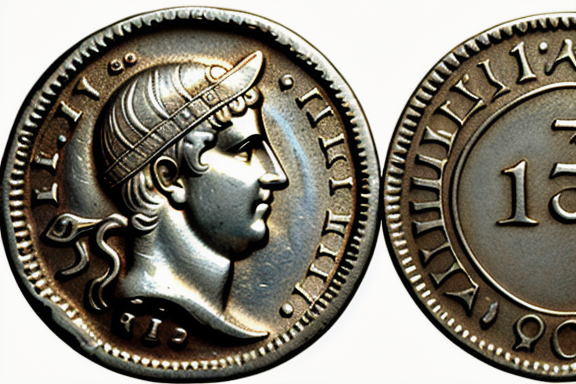The Value of Money in the Bible
The Bible is a treasure trove of wisdom and knowledge, offering guidance on various aspects of life, including money. Understanding the value of money in the biblical context can provide insights into the economic systems and cultural practices of the time. It allows us to explore the significance of monetary transactions, the lifestyle of people, and the societal norms prevalent during biblical times.
In the Bible, various currencies were used for trade and commerce, with one of the most commonly mentioned coins being the denarius. The denarius was a silver coin that held significant value in the Roman Empire during the time of Jesus and the early Christian era. It was the standard wage for a day’s labor and was often used as a benchmark for comparing other monetary values.
The value of 300 denarii in the Bible was significant. To put it into perspective, imagine someone earning 1 denarius per day. It would take that person nearly a year to accumulate 300 denarii. This amount of money could be used to purchase various goods and services, providing a comfortable living for an extended period.
It’s important to note that while the denarius was a widely recognized currency, other types of coins, such as the shekel, mina, and talent, were also mentioned in the Bible. Each coin had its own value and significance, often varying based on the region and time period. Understanding the value of these coins provides a deeper understanding of the biblical stories and the economic context in which they unfolded.

Understanding Denarii
Denarii played a significant role in biblical times, serving as a unit of currency and holding both economic and cultural value. To gain a deeper understanding of denarii, it is important to explore its presence in the Bible, its historical context, and its significance as a unit of currency.
Denarii in the Bible
In the Bible, denarii are mentioned several times, often in parables and teachings of Jesus. One notable instance is the Parable of the Workers in the Vineyard, where denarii are used as a measure of fair wages for a day’s work (Matthew 20:1-16). This demonstrates the importance of denarii as a representation of value in biblical times.
Another significant mention of denarii is found in the story of the Widow’s Offering (Mark 12:41-44). Jesus observes a poor widow who puts two small copper coins, worth a fraction of a denarius, into the temple treasury. Despite its small value, Jesus praises her act, highlighting the importance of sacrificial giving.
Historical Context
During the time of the Bible, denarii were the principal silver coin of the Roman Empire. Introduced by the Roman Republic in the late 3rd century BC, denarii became the standard currency of the empire in the 1st century BC. They were minted in Rome and circulated throughout the Mediterranean region.
Denarii were made of silver and had a standardized weight of approximately 3.9 grams. The coin featured various designs, including the profile of the emperor on one side and various symbols and inscriptions on the other. These coins were widely used for trade, taxation, and everyday transactions.
Denarii as a Unit of Currency
The value of denarii varied throughout history, influenced by factors such as inflation, economic conditions, and political stability. In biblical times, a denarius was typically equivalent to a day’s wage for a skilled laborer. However, it is important to note that the value of denarii could fluctuate depending on the region and time period.
According to historical records, the average wage for a skilled laborer ranged from 1 to 2 denarii per day. This provides insight into the value of money and the cost of living during biblical times. It also helps us understand the significance of certain biblical references to denarii, such as the Parable of the Workers in the Vineyard.
Determining the Worth of 300 Denarii
The denarius was a widely used currency in biblical times, and understanding its worth can provide valuable insights into the economic context of the period. To determine the value of 300 denarii, we need to consider its relative value, purchasing power, and make a comparison to modern currency.
Relative Value
The value of the denarius fluctuated throughout history, but during the time of Jesus, it was commonly used as a day’s wage for a skilled laborer. This gives us an idea of its relative value in comparison to other currencies and commodities of the time.
It’s important to note that the denarius was not the only currency in circulation during biblical times. Other currencies, such as the shekel, were also used. However, the denarius was the most widely recognized and accepted currency, especially in the Roman Empire.
Purchasing Power
To understand the purchasing power of 300 denarii, we can look at the prices of goods and services during that period. For example, a single denarius could buy approximately 8 liters of wheat or 12 liters of barley, which were staple foods at the time.
Additionally, a denarius could also cover the cost of a pair of sandals or a basic tunic. However, luxury items such as fine clothing, jewelry, or imported goods would require a significantly larger sum of money.
Comparison to Modern Currency
Comparing the value of 300 denarii to modern currency is a challenging task due to the vast differences in economic systems and inflation rates. However, we can make an estimation to provide some perspective.
One approach is to consider the price of gold, which has been used as a store of value throughout history. During biblical times, an ounce of gold could be bought for around 300 denarii. Using the current price of gold, we can make a rough comparison.
As of the current gold price, 300 denarii would roughly equate to around $6,000 to $7,000 USD. However, it’s important to note that this estimation is based on various assumptions, and the true value could vary.
Understanding the worth of 300 denarii provides us with a glimpse into the economic realities of biblical times. It highlights the purchasing power of the currency and helps us appreciate the value of goods and services in that era.
The Significance of 300 Denarii in Biblical Context
In conclusion, the value of 300 denarii in biblical times held significant meaning and implications. By exploring its relative value, purchasing power, and comparison to modern currency, we can gain a deeper understanding of its significance in biblical narratives.
Relative Value: 300 denarii was a substantial sum of money in biblical times. It represented a significant portion of an individual’s wealth and could be used to purchase various goods and services. Its value was influenced by factors such as economic conditions, supply and demand, and the overall financial status of the region.
Purchasing Power: With 300 denarii, one could afford a range of commodities and necessities. For example, it could cover the cost of a modest home, livestock, or a year’s supply of food for a family. The purchasing power of 300 denarii allowed individuals to meet their basic needs and provide for their families.
Comparison to Modern Currency: While it is challenging to draw a direct comparison between ancient denarii and modern currency, some estimates suggest that 300 denarii would be equivalent to a significant sum in today’s world. Taking into account inflation, economic factors, and the differences in economic systems, it could be roughly equivalent to several thousand dollars or more.
Understanding the value of 300 denarii in biblical times helps us contextualize the significance of its mention in biblical narratives. It provides insight into the economic realities of the period, the lifestyle of individuals, and the importance of financial resources in daily life.
FAQ:
Q: Were denarii the only form of currency in biblical times?
A: No, denarii were one of the common forms of currency in biblical times, but other currencies such as shekels, talents, and drachmas were also in use. Each currency had its own value and significance in different regions and contexts.
Q: How did the value of denarii vary across different biblical periods?
A: The value of denarii fluctuated over time due to various factors like political instability, economic conditions, and shifts in trade. The purchasing power of denarii may have differed between different historical periods and regions.
Q: Did the value of denarii remain constant throughout biblical times?
A: No, the value of denarii changed over time due to economic factors, inflation, and fluctuations in the availability of resources. It is important to consider the specific biblical context when discussing the value of denarii.
Q: How did people earn denarii in biblical times?
A: People earned denarii through various means, including agricultural work, trade, craftsmanship, and other forms of labor. The amount of denarii earned varied depending on the occupation and the economic opportunities available in a particular region.

Rockin’ the faith, one verse at a time!
Growing up, the Bible’s stories deeply impacted me. Now, with over 15 years of preaching experience, I blend timeless teachings with modern technology, making them relevant for today’s world.
Bible Hub Verse is my platform to share historical insights and thought-provoking articles, exploring both familiar and uncommon Christian topics. My passion is building a welcoming online space for everyone to learn, grow in their faith, and discover the Bible’s enduring message.
Join the journey!
God bless you.





